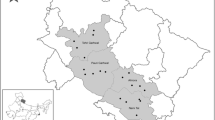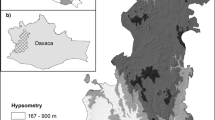Abstract
This study documents natural resource use in a forest-adjacent western Ugandan village, and explains how what superficially appears to be a sustainable scenario is in fact quite unstable. Kibwona village is adjacent to Kasokwa Forest, comprised of a small Central Reserve owned by the National Forest Authority (NFA) and several contiguous community forests. Firewood and water collection is legal. However, empirical observations of women’s daily activity budgets and details of resource acquisition show on average, women spent less than 5% of the time collecting natural resources. This is true for resources both in and out of the forest. This may be simply because firewood within household compounds, gardens and woodland–bush areas is abundant, accessible, and closer than the (also close) forest. However, two additional reasons for this behavior may, in fact, hinder long-term sustainability: (1) Many locals also plant eucalyptus trees for firewood, poles, and timber, which, although it is fast growing and makes good firewood, is water-draining and hard on the soils and thus a high cost to subsistence farmers. (2) Fears of harassment by NFA officials when collecting firewood inhibit local people from even entering the forest. Decentralized, collaborative forest management will not happen under oppressive and fear-based relationships, nor can a sustainable firewood supply be based on eucalyptus.



Similar content being viewed by others
Notes
Although we brought binoculars and a bird book so as not to appear to be solely watching the woman’s activities, our presence undoubtedly had some affect on her chosen activities. In terms of resource use and collection, however, daily activities can not be avoided as there are families to feed and household compounds to be tended.
References
Benjaminsen, T. A. (1997). Natural Resource Management, Paradigm Shifts, and the Decentralization Reform in Mali. Human Ecology 25: 1121–143.
Chapman, C., Naughton-Treves, L., Lawes, M., Wasserman, M., and Gillespie, T. (2007). Population Declines of Colobus in Western Uganda and Conservation Value of Forest Fragments. International Journal of Primatology 28(3): 513–528.
Chokkalingham, U., and De Jong, W. (2001). Secondary Forest: A Working Definition and Typology. International Forestry Review 3: 119–26.
Cooke, P., Kohlin, G., and Hyde, W. (2008). Fuelwood, Forests and Community Management: Evidence from Household Studies. Environment and Development Economics 13: 103–135.
Coombs, W. A. (2007). Kasokwa Forest Project, Kasokwa Corner. Budongo Conservation Field Station News 8: 314–15.
EASD (1996). State of the environment report, Uganda, Empowerment for African Sustainable Development, Available at: http://easd.org.za?download.asp?path=Uganda_soe_1996.pdf&Is=File.
Eilu, G., Hafashimana, D., and Kasenene, J. (2004). Density and Species Diversity of Trees in Four Tropical Forests of the Albertine Rift, Western Uganda. Diversity Distribution 10(4): 303–312.
Embree, B., and Whitehead, P. (1993). Validity and Reliability of Self-Reported Drinking Behavior: Dealing with the Problem of Response Bias. Journal of Studies on Alcohol 54: 334–344.
Gahigana, I. (2006). “No More Eucalyptus Trees, Says Official.” AllAfrica.com 27 Sept Available at: http://www.worldagroforestrycenter.org/af1/index.php?id=242&NewsID=A5693D35-1D9D-4197-A543-115948BD18C4
Gardner, R. (2007). Investigating the Environmental Adaptability of Promising Subtropical and Cold-Tolerant Eucalypt Species in the Warm Temperate Climate Zone of KwaZulu-Natal, South Africa. Southern Hemisphere Forestry Journal 69: 127–38.
Geores, M. (2003). The relationship between resource definition and scale: considering the forest. In Dolsak, N., McCay, B. J., and Elinor Ostrom, E. (eds.), The Commons in the New Millennium: Challenges and Adaptation. MIT Press, Cambridge, pp. 77–98.
Katende, A., Birnie, A., Tengnaes, B. (1995) Useful trees and shrubs for Uganda: identification, propagation and management for agricultural and pastoral communities. Technical Handbook—Regional Soil Conservation Unit, RSCU (Kenya), no. 10.
Kayanja, F. I. B., and Byarugaba, D. (2001). Disappearing Forests of Uganda: The Way Forward. Current Science 81: 8936–947.
Kersten, I., Baunbach, G., Oluwole, A., Obioh, I., and Ogunsola, O. (1998). Urban and Rural Fuelwood Situation in the Tropical Rain-Forest Area of South-West Nigeria. Energy 23: 10 887–898.
Kituyi, E., Marufu, L., Wandiga, S., Jumba, I., Andreae, M., and Helas, G. (2001). Biofuel Availability and Domestic Use Patterns in Kenya. Biomass & Bioenergy 20(2): 71–82.
Lanfranco, D., and Dungey, H. (2001). Insect Damage in Eucalyptus: A Review of Plantations in Chile. Austral Ecology 26: 5477–481.
Makundi, W., and Okitingati, A. (1995). Carbon Flows and Economic Evaluation of Mitigation Options in Tanzania’s Forest Sector. Biomass & Bioenergy 8: 5381–393.
Marufu, L., Ludwig, J., Andreae, M., Lelieveld, J., and Helas, G. (1999). Spatial and Temporal Variation in Domestic Biofuel Consumption Rates and Patterns in Zimbabwe: Implications for Atmospheric Trace Gas Emission. Biomass & Bioenergy 16(5): 311–332.
McElhinny, C., Gibbons, P., Brack, C., and Bauhus, J. (2005). Forest and woodland stand structural complexity: Its definition and measurement. Forest Ecology and Management 218(1–3): 1–24.
MWLE (2002). National Biomass Study technical report of 1996–2002. Ministry of Water, Lands and Environment (MWLE), Uganda.
Namaalwa, J., Sankhayan, P., and Hofstad, O. (2007). A Dynamic Bio-economic Model for Analyzing Deforestation and Degradation: An Application to Woodlands in Uganda. Forest Policy and Economics 9(5): 479–495.
Nangendo, G., Ter Steege, H., and Bongers, F. (2006). Composition of Woody Species in a Dynamic Forest-woodland-savannah Mosaic in Uganda: Implications for Conservation and Management. Biodiversity and Conservation 15(4): 1467–1495.
Naughton-Treves, L., Kammen, D., and Chapman, C. (2007). Burning Biodiversity: Woody Biomass Use by Commercial and Subsistence Groups in Western Uganda's Forests. Biological Conservation 134(2): 232–241.
Niskanen, A. (1998). Financial and Economic Profitability of Reforestation in Thailand. Forest Ecology And Management 104: 1–357–68.
Ong, C. (2007). How much water do trees take? A new technology to measure trees water uptake has been unveiled. Technews Africa July:22023.
Osei, W. Y. (1993). Woodfuel and Deforestation—Answers for a Sustainable Environment. Journal of Environmental Management 37: 151–62.
Pain, D., Fishpool, L., Byaruhanga, A., Arinaitwe, J., and Balmford, A. (2005). Biodiversity Representation in Uganda's Forest IBAs. Biological Conservation 125(1): 133–138.
Puri, S., and Nair, P. (2004). Agroforestry Research for Development in India: 25 years of Experience of a National Program. Agroforestry Systems 61: 437–452.
Reynolds, V. (2005). The Chimpanzees of Budongo Forest: Ecology, Behavior and Conservation,. Oxford University Press, Oxford.
Reynolds, V., Wallis, J., and Kyamanywa, R. (2003). Fragments, sugar and chimpanzees in Masindi District, Western Uganda. In Marsh, L. (ed.), Primates in Fragments: Ecology and Conservation, Kluwer Academic/Plenum Publishers.
Ross, C., and Mirowsky, J. (1983). The Worst Place and the Best Face. Social Forces 62: 529–536.
Schroeder, R. (1999). Community, Forestry and Conditionality in the Gambia. Africa 69: 11–22.
Stocke, V., and Hunkler, C. (2007). Measures of Desirability Beliefs and their Validity as Indicators for Socially Desirable Responding. Field Methods 19: 313–336.
Sunderlin, W. D. (2005). Special Issue—Livelihoods, Forests, and Conservation. World Development 33: 91379–1381.
Tabuti, J., Dhillion, S., and Lye, K. (2003). Firewood Use in Bulamogi County, Uganda: Species Selection, Harvesting and Consumption Patterns. Biomass & Bioenergy 25(6): 581–596.
Turyahabwe, N., Geldenhuys, C., Watts, S., and Obua, J. (2007). Local Organisations and Decentralised Forest Management in Uganda: Roles, Challenges and Policy Implications. International Forestry Review 9(2): 581–596.
van den Broek, R., van den Burg, T., van Wijk, A., and Turkenburg, W. (2000). Electricity Generation from Eucalyptus and Bagasse by Sugar Mills in Nicaragua: A Comparison with Fuel Oil Electricity Generation on the Basis of Costs, Macro-economic Impacts and Environmental Emissions. Biomass and Bioenergy 19(5): 311–335.
Acknowledgements
As always, thank you to Joseph Karamagi, trusted field assistant and friend. My gratitude to Bobbi Low, Arun Agrawal, Howard Stein, Rebecca Hardin, the Bobbi Lab group, and two anonymous reviewers for useful comments throughout the writing of this paper. This research was funded in part by the Rackham Graduate School, the School of Natural Resources and Environment, and The Society for the Psychological Study of Social Issues.
Author information
Authors and Affiliations
Corresponding author
Rights and permissions
About this article
Cite this article
Watkins, C.A. Natural Resource Use Strategies in a Forest-Adjacent Ugandan Village. Hum Ecol 37, 723–731 (2009). https://doi.org/10.1007/s10745-009-9268-8
Published:
Issue Date:
DOI: https://doi.org/10.1007/s10745-009-9268-8




